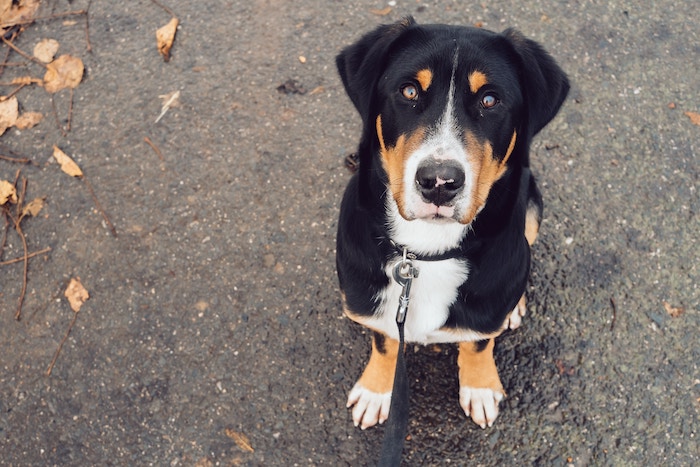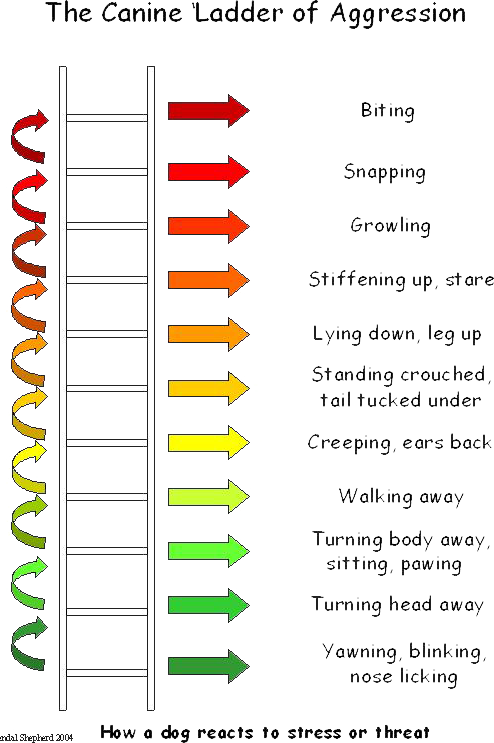
“Dogs are very honest, they’ll always tell you what they’re thinking; we just have to be listening” – Dr. Karen vanHaaften, DVM, DACVB
As part of the Vancouver Parks Board Dogs for the Environment series, Kim Monteith, Manager of Animal Welfare at the BCSPCA, spoke to dog owners about dog training and understanding our furry friends through reading and responding to their body language. Ms. Monteith provided a straight-forward framework to use to understand dogs (and other animals). Here’s a quick breakdown of this excellent session.
How dogs learn – Consequences and Associations
Re-Enforcing Good Behaviour with Rewards (Positive Consequence)
Dogs only understand immediate consequences. If you’re trying to build preferred good behaviours, reward ‘good’ behaviour immediately. Kim Monteith demonstrated that even eight-week-old puppies quickly learn to sit if they are immediately rewarded with a treat when their bums are on the ground.
This same dog training process has been used with other animals such as cats and zoo animals. Although most of us use food treats for dog training, you can use whatever is valued by your pet; praise, treats, toys, off leash time, open door, time with another dog, etc.
Re-Enforcing Good Behaviour through Association (Positive Associations)
Dogs also form associations, noticing when events tend to happen one after another. A dog’s emotions can be associated with objects, places or situations. These can be either positive or negative associations; for example a leash means a walk, or a car ride means a trip to the dog-park or beach, while the vet’s office might mean discomfort.
Everything you do around your dog influences the associations they make. If there’s a bad association, like the vet’s office, you have to build a positive association with the office or vet, whatever it is that scares them, so they can learn to be comfortable, and then you turn the association into something more positive.
How dogs see the world – Dangerous or Not, Works or Not
Dogs are simple; they see the world in terms of what is safe vs. what is dangerous, and what works vs. what doesn’t work. They don’t think in terms of right vs. wrong, like we do. When you look at the world on their terms, everyday activities (such as dog training) take on a new perspective.
Safe versus Dangerous
Receiving a correction from it’s owner may be interpreted by the dog as a dangerous situation. For example, if you scold a dog for urinating in the living room, you may think you’re house training them. They may interpret it as ‘its dangerous to pee around you’, so they’ll go somewhere ‘safe’, like another room, to do their business.
What Works versus What Doesn’t Work
Dogs also think in terms of what works vs what doesn’t work. They’re thinking this even when we’re not. Even though the fridge is filled with all sorts of goodness, they learn that staring at fridge doesn’t work. They may learn though that staring at their owner (often with those cute doggy eyes) may in fact get them a treat, because occasionally you give them a treat. Staring at you works.
As caretakers of our pets then, the dog training path to follow for preferred behaviour is:
- Be patient
- Careful what we pay attention to
- Careful what we ignore
Knowing this, you have to patiently change up your training towards good consequences and positive associations. For example, it’s a patient journey of dog training to get them to do their business outside. Remembering to build a positive association with eliminating outside. Pee outside = treat, ignore accidents in house and manage your dog so they don’t have an accident inside.
‘Listen’ to your dog – Understanding Body Language
Early Signs of Apprehension (or Worry)
While dogs lack the verbal linguistic skills we’d like them to have, their body language will tell us what we need to know about how they feel. Early signs that a dog might be feeling uncomfortable, fearful, worried, or apprehensive are:
- Liking lips while not eating
- Looking away from source of stress
- Panting when not exercising or hot
- Yawning when not tired or bored
- Showing white of the eyes
- Tense face or body
- Flattening of ears against the side of hear
- Trying to move away
In many situations, especially stressful ones, you’re basically asking them a question and waiting for their response. Your job is to give them space, literally physically and emotionally, to respond. For example, if you’re introducing something or someone to them, give them the space and opportunity to back away. If they do show signs of stress (eg turning away or backing away), you give them the opportunity to act on their feelings and move away from the threat (even if we feel its not a ‘real’ threat) to feel a bit safer. This can avoid negative escalations like bites, etc. (You can then also start forming a positive associations with the ‘threat’. )
Heightened Signs of Stress or Anxiety
All dogs are different, so individual behaviour varies and may be subtle. You can start by studying your dog to understand their signs when they’re both happy and stressed, and their baseline when comfortable. You can then move to watching other dogs to help understand them in different situations. Higher up in escalation, try to recognize signs of fear, anxiety & stress:
- Withdrawal

- Avoidance
- Salivating
- Lower body tense
- Turning Away
- Licking Lips
- Lowering head
- Shaking / trembling
- Urination / defecation
- Ears back
- Freezing
- Tail tucked
- Hiding
- Attempts to get away
- Decreased or No Appetite
- Curved back
The Canine Latter of Aggression is a great tool to use to start understanding dog behaviour. Get to know how your dog and other dogs are feeling to prevent incidents and protect all dogs and people. If you see early signs of an upcoming issue, you can redirect beforehand. Ideally you can work with them to train towards a better association with whatever the trigger is, e.g. a stranger approaching.
Thanks again to the City of Vancouver Parks Department and Kim Monteith for this great session. She demonstrated her knowledge and passion to improve the lives of animals through moving away from antiquated views that animals must be dominated/threatened to be trained.
